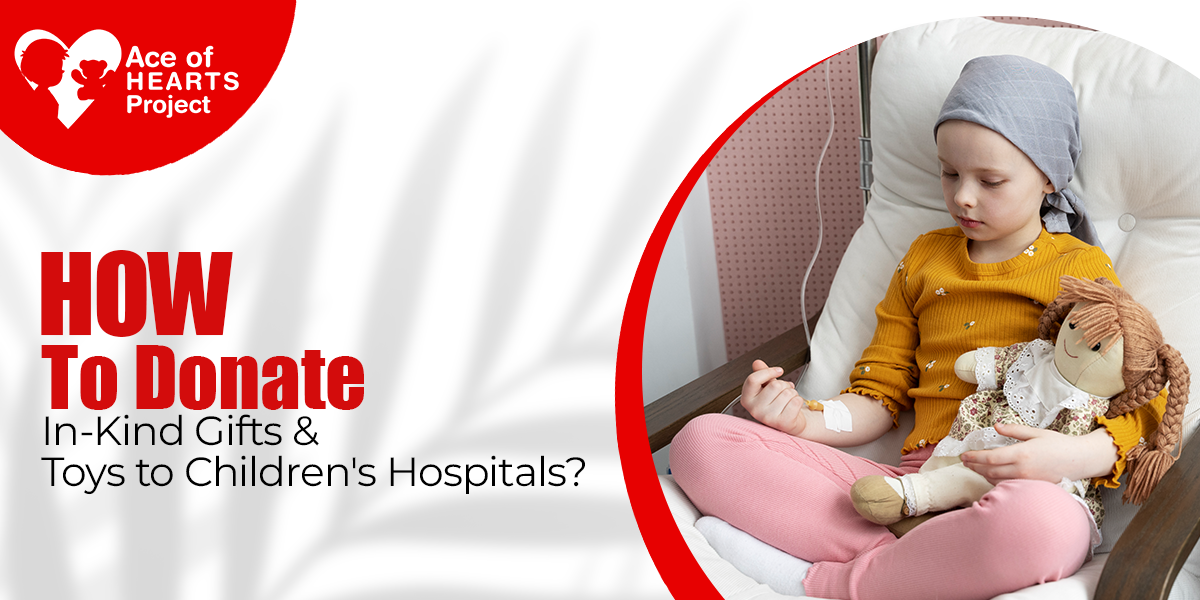How to Donate In-Kind Gifts and Toys to Children's Hospitals
The entire world has experienced several crises, ranging from natural disasters and pandemics to economic downturns. The impulse to spread kindness, however, endures despite all the uncertainty. Children in hospitals require more emotional support than ever before as families continue to face difficult times, particularly in the wake of medical emergencies and international instability. When you donate toys to charity and gift toys to hospitals can make all the difference for these young patients. Moreover, giving something tangible is not enough, you need to give them joy, hope, and a reminder that they are not forgotten.
Furthermore, hospitals are aggressively promoting the donation of in-kind gifts to improve children’s moods during treatment as a result of growing awareness about mental health, particularly among pediatric patients. Giving gifts and in-kind goods to children’s hospitals may be one of the most meaningful things you can do if you have ever wondered how you might truly make a difference.
Why Donate In-Kind Gifts & Toys?
Children undergoing medical treatment often face long hospital stays, separation from their families, and emotionally taxing experiences. In-kind donations—like toys, books, games, or art supplies—can help reduce stress and provide comfort and distraction. For many of these children, play becomes therapy.
Moreover, hospitals often rely on community support to supplement their child life programs. When you donate toys to charity organizations or directly donate toys to Children's Hospital, you help create a more nurturing environment for healing and recovery.
Types of Acceptable In-Kind Donations
Before gathering items for donation, it’s crucial to know what is generally accepted. Children’s hospitals usually have strict health and safety protocols, especially due to vulnerable immune systems among patients.
Commonly Accepted Items:
Brand new toys (unopened, in original packaging)
Board games and puzzles
Stuffed animals (must be new and free from allergens)
Craft supplies (non-toxic paints, coloring books, crayons, etc.)
Books (especially picture books and young adult fiction)
Gift cards (for online retailers, entertainment, or food delivery)
Teen-approved items (like journals, headphones, and card games)
Items Often NOT Accepted:
Used toys (due to infection risks)
Violent-themed toys (guns, swords, etc.)
Latex balloons (can be choking hazards or allergenic)
Perishable food items
Religious materials (unless approved)
So, always check the hospital’s donation guidelines beforehand, as each institution may have unique rules based on patient demographics and safety standards.
Step-by-Step Guide: How to Donate
1. Research the Right Hospital or Charity
Start by identifying local or national children’s hospitals that accept toy donations. Some have dedicated child life services with donation drop-off areas or scheduled donation days. Moreover, you can also go through nonprofits and foundations that distribute toys to hospitals.
Use online directories or search for the best place to donate toys in your city. If you're unsure, websites of prominent hospitals usually have a "Ways to Give" section.
2. Review the Hospital’s Donation Policy
Visit the hospital’s website or call their donations department. Look for:
Approved toy lists
Drop-off dates and hours
Volunteer or delivery restrictions
Gift packaging requirements
Additionally, some hospitals only accept donations during specific seasons or require prior approval.
3. Purchase the Items
Choose new, age-appropriate toys based on the hospital’s needs. It's a good idea to select toys that are:
Easy to clean and sanitize
Free of small, detachable parts
Inclusive (diverse books, characters, and themes)
Further, make it fun by involving your children, friends, or colleagues in a shopping spree with a purpose!
4. Consider Group Donations or Toy Drives
Team up with your community, school, or workplace to collect toys as a group. Organizing a toy drive can multiply your impact and spread awareness. Moreover, just be sure to coordinate with the hospital ahead of time to ensure the volume and type of items are manageable.
5. Label and Package Donations Properly
Avoid wrapping gifts, unless the hospital specifically asks for it. Most prefer items in clear, labeled bags or boxes. Also, clearly note the age group the toy is intended for, such as “Ages 3–5” or “Teens.”
6. Make the Delivery
Most hospitals designate a specific area or schedule for drop-offs. Some may only accept mail-in donations for safety reasons. If in-person drop-off is allowed, be sure to follow any health protocols like mask mandates or appointment scheduling.
Also, don’t forget to request a donation receipt if you plan to claim a tax deduction.
Creative Ways to Make an Impact
If you want to go beyond a one-time donation, here are some thoughtful ways to continue supporting children in hospitals:
Celebrate Birthdays by Donating
Ask friends and family to donate toys instead of giving birthday gifts. It also teaches children generosity and makes your celebration more meaningful.
Holiday-Themed Drives
Organize Christmas, Hanukkah, or Eid-themed toy drives. Holidays can be especially lonely for hospitalized children, and receiving gifts can bring festive cheer.
Donate in Honor of Someone
Donate in the name of a loved one, whether it’s for a birthday, a memorial, or just because. Hospitals often allow you to personalize the gift with a tag or card.
Partner with Businesses
Ask local businesses to contribute or match your donations. Many companies are open to collaborating on charity initiatives, especially when they align with community welfare.
Things to Remember
Be thoughtful: Consider donating items that promote education, creativity, or emotional comfort.
Follow rules: Hospitals have donation guidelines to protect the health and safety of their patients.
Ask first: If you’re unsure whether an item is acceptable, contact the hospital or charity directly.
Avoid last-minute donations: Plan, especially around the holidays, when hospitals may be overwhelmed with gifts.
To Conclude
Therefore, donating toys to hospitals for children is a better way to bring light into a child’s life during difficult times. It is more about the message you give with the gift- ‘You are loved, you are strong, and you are not alone’.
So, if you are looking for the best charity to donate toys, contact ‘Ace of Hearts’. By donating toys, you can create a ripple effect of compassion. Also, in a world of chaos, small acts of kindness can restore faith and brighten someone’s day.
Now, go ahead—pick up that teddy bear, pack that puzzle box, or wrap that coloring set. Your small gift might just spark a big smile.

